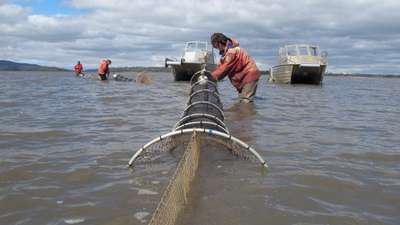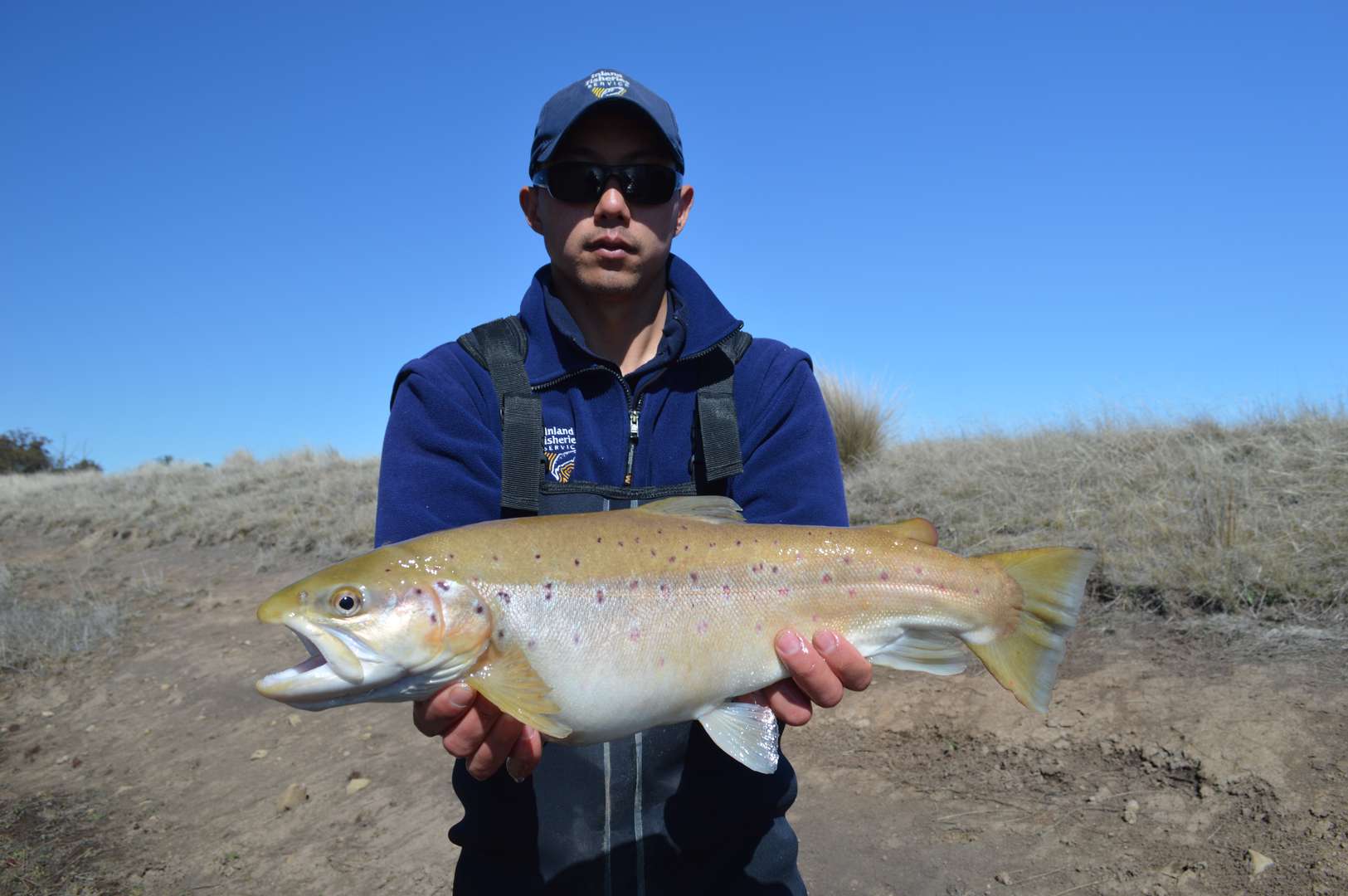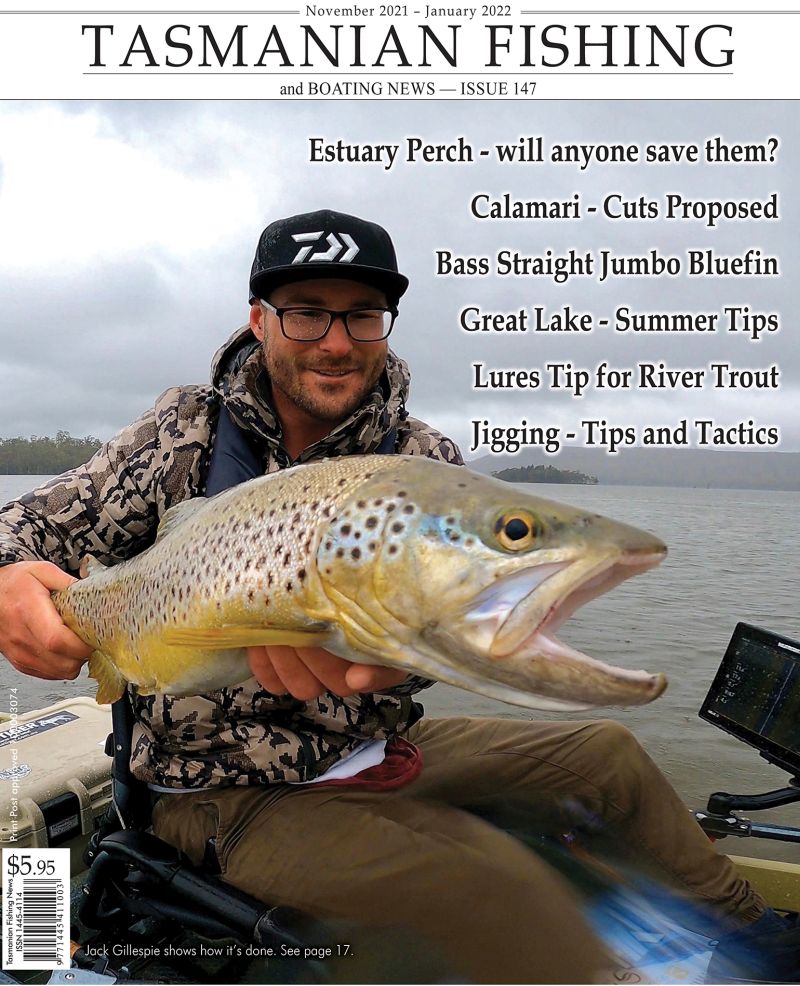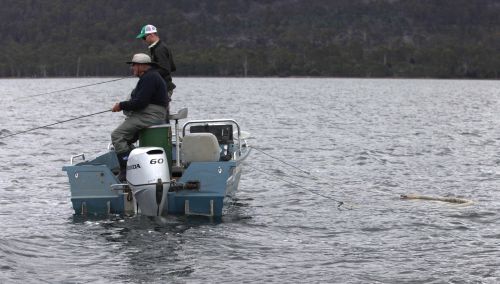From the Archives ...
Early season - Bob McKinley
Presented from Issue 105, August 2013
Bob is a professional fishing guide and guides for trout and estuary species. Check him out at www.fishwildtasmania.com
There are several things we look for in our early season trout waters. It is still winter and cold, so some of the things to consider are: Altitude as this dictates the water temperature and therefore feeding activity. Food for the fish. Availability of trout food is generally dictated by the quantity and quality of weed beds.
Quantity of fish.
Three waters which I believe fit all three requirements are:
Read more ...|
|
|
Brown trout from salvage |
Over the past couple of days we have salvaged 348 trout from the River Clyde downstream of the Lake Crescent outlet. As there is no requirement for a water release at present these fish had become restricted in their movements.
Of these 171 were returned to Lake Crescent and 177 were released into Lake Sorell. The fish ranged in size up to 3.5kg.
Source: https://www.ifs.tas.gov.au/news/2020/may/26/fish-released-lake-sorell-salvage
- Written by Stephen Smith - Rubicon Web and Technology Training
- Category: Lake Sorell
- Hits: 2072

We focused on areas that carp like. These include rocky or sandy shores and spaces with lots of weed. We fished fourteen areas around the lake using backpack electro-shockers. We caught short-finned eels and golden galaxias but no carp.
- Written by Stephen Smith - Rubicon Web and Technology Training
- Category: Lake Sorell
- Hits: 2648
Read more: Lake Crescent remains carp free, and no spawning in Lake Sorell!
Carp in Lake Sorell
For many southern anglers Lake Sorell has been one of the most popular, accessible and productive brown trout fisheries. Its shores were home to private shacks, club shacks, and hundreds of campers.
That is until the sudden infestation of carp, a problem that continues to plague this water. Despite continuing efforts since 1995 by the Inland Fisheries Service to eradicate the pest, the Spring of 2009 saw an increase in juvenile carp which, according to IFS Director, John Diggle, was “the biggest spawning event we have had.”
It is estimated that around 5,000 carp are now swimming around Lake Sorell where as prior to last year’s spawning, numbers were less than 50.
According to the Director, “The good thing is that these fish are all juveniles and as they are unable to breed for a couple of years we have a window of opportunity to wipe them out.”
IFS staff have already taken out over 14,000 carp from Lake Sorell last summer, and it is vital to eradicate mature carp as soon as possible as a four kilogram carp has the potential to lay one million eggs.
John Diggle believes Lake Crescent is now free of carp and that, in itself, is quite an achievement. No juveniles have been found since 2000, and no adult females have been detected for nearly three years. According to Diggle, “It is a clear demonstration that we can and will eradicate carp from Lake Sorell.”
Although carp do eat some macro-invertebrate species that brown trout also enjoy, they are not predators of trout fry or fingerlings. The issue is what carp can do to the food chain and to the water quality.
Compounding the presence of carp in Lake Sorell is the issue of poor water quality resulting from drought conditions. This is also impacting on Lake Crescent. Both waters have high levels of turbidity – colloidal particles in suspension which don’t settle to the bottom of the lake bed. According to Diggle, “It’s a bit like a farm dam that doesn’t clear, and that just isn’t attractive to anglers.”
Whilst this is a result of drought conditions in this part of the island, low water levels back in 2000 also contributed, especially in Lake Sorell where there has been some erosion of the lake bed.
Currently the water management plan for the Clyde catchment area is under review, and there will obviously be some discussion around critical minimum water levels necessary to sustain both trout fisheries, and especially for the protection of Golden Galaxias in Lake Crescent. No doubt other stakeholders – irrigators and local town water supplies – will be seeking their share of the resource. But there is no doubt that the IFS is putting a strong case for critical minimum water levels so that this fishery can once again be a prime destination for trout anglers.
If water levels can be sustained, the carp eradicated, and water turbidity controlled there is no reason why Lake Sorell can’t regain its former status as one of the state’s top fisheries which used to attract 50% of the state’s anglers in any one season. Afterall, there is a very good head of fish in Sorell resulting from excellent natural spawning conditions, albeit dependent upon variable rainfall patterns.
According to the IFS Director, “That’s what I want … that’s what I have been working on for years. However, our problem may not be so much about carp or water quality but climate change. If the things people are saying about climate change are true, and it is only going to get drier than we are now, the future may not so promising for either lake, or for most of the eastern part of the island.”
Then again, Lake Dulverton is now full and has been stocked; Tooms Lake is spilling and has also been stocked; and Craigbourne Dam should again deliver angling delights for southern family expeditions to this water.
So it looks like at least two years before Lake Sorell will again be open for anglers, although the IFS will assess the situation at the end of each summer.
- Written by Stephen Smith - Rubicon Web and Technology Training
- Category: Lake Sorell
- Hits: 5327
Lake Sorell – Reminder about Special Closure
by Sarah GrahamThis is a reminder to anglers that Lake Sorell is closed for fishing. It was closed at the start of the 2010-11 angling season and will most likely remain closed next season. To avoid disappointment, anglers might instead consider going to Lake Crescent which is open for fishing.
- Category: Lake Sorell
- Hits: 9696
Carp Eradication
Carp eradication in Tasmania's lakes Crescent and Sorell gains worldwide coverage. Click on the link below to see a story on carp from the other side of the world.
http://www.jsonline.com/news/wisconsin/111329919.html
- Category: Lake Sorell
- Hits: 7049
New strategy implemented to combat carp in Lake Sorell
The attempt to eradicate carp from Tasmania hangs in the balance. While there is a good chance that carp can be eradicated from Lake Crescent, Lake Sorell poses greater problems. Over 7700 carp have been removed from Lake Crescent since they were officially found back in February 1995. There has been a steady fish down and the last mature female captured from this lake was in November 2003. There has been no successful recruitment in this water since the year 2000. Any females that remain should be on the verge of becoming sexually mature in the coming spawning periods (October-January). Population estimates show that if there are any females the numbers they will be very low.- Category: Lake Sorell
- Hits: 8867
Read more: New strategy implemented to combat carp in Lake Sorell
Sorell area well worth a visit
There is plenty of variety available in the Sorell area, as Adam Hill explains.
There are many good fish to be caught in my local area, the South East Region, for whatever form of fishing you like i.e. bait, lure or surf fishing.
- Category: Lake Sorell
- Hits: 10446
Current TFBN
Click above for current issue content. The current issue of TFBN is extensive and topical. In Tackle Stores, Newsagents and by subscription.
Delivered to your door for $48 for 2 years (8 issues). To subscribe, send Mike $48 via www.paypal.com.au . (Basic instructions are here) The email is at Contact Us. Your address will be included from PayPal.
Or phone Mike with your c/c handy on 0418129949
Please ensure your details are correct, for Mike to organise delivery.
TFBN Newsletter Sign up Form
Why not submit an article ?
When you have finished for the day, why not have a brag about the ones that didn't get away! Send Mike an article on your fishing (Click here for contact details), and we'll get it published here. Have fun fishing - tasfish.com
Category Descriptions
Here is a list of all of the Article Categories. The number in Brackets, eg (13) is the number of articles. Click on Derwent River and all articles relating to the Derwent will be displayed in the central area.
Articles by Category
-
Rivers (3)
-
Saltwater and Estuary Fishing (149)
-
Kayak Fishing (34)
-
Lakes (1)
-
Great Lake (62)
-
Lake Leake (52)
-
Woods Lake (16)
-
Lake Augusta (11)
-
Huntsman Lake (13)
-
Lake Pedder and Gordon (10)
-
Lake Dulverton (5)
-
Lake Crescent (6)
-
Tooms Lake (10)
-
Lake Mackintosh (2)
-
Lake Barrington (5)
-
Little Lake (8)
-
Meadowbank Lake (5)
-
Lake King William (7)
-
Lake St Clair (2)
-
Western Lakes (12)
-
Arthurs Lake (35)
-
Lake Echo (7)
-
Four Springs (54)
-
Lake Sorell (7)
-
Lake Burbury (6)
-
Other Lakes (57)
-
Brushy Lagoon (18)
-
Little Pine Lagoon (5)
-
Penstock Lagoon (16)
-
Brumbys Creek (7)
-
-
Events (48)
-
Estuary Fishing (0)
-
Coastal Catches (46)
-
Super Trawler (46)
-
IFS, DPIPWE, MAST and Peak Bodies (435)
-
Commercial Interests (98)
-
Other (24)
-
TFBN Back Issues (8)
-
Fly Fishing (67)
-
Trout Fishing (252)
-
Meteorology and Weather (8)
-
Jan’s Flies (50)
-
Tuna Fishing and other Game Fishing (86)
-
Cooking Fish (19)
-
Fishing Information (1)
-
Fishing Books (8)
-
Videos (5)
-
Tackle, Boats and other Equipment (146)
-
World Fly Fishing Championship 2019 (2)
Popular Tags
windyty.com
Visit https://www.windyty.com/
Rubicon Web and Technology Training
Hello everyone, I thought it would be a good time to introduce myself.
My name is Stephen Smith and I have been managing the website tasfish.com since May 2009.
It has been an epic journey of learning and discovery and I am indebted to Mike Stevens for his help, support and patience.
I am developing a new venture Rubicon Web and Technology Training ( www.rwtt.com.au ). The focus is two part, to develop websites for individuals and small business and to train people to effectively use technology in their everyday lives.
Please contact me via www.rwtt.com.au/contact-me/ for further information - Stephen Smith.
From the Archives ... (last chance)
Fishing on the Wild Side
Fishing on the Wild Side
Mike Fry doesn’t only live on the Wild Side of Tasmania, but also goes fishing in probably the wildest boat ever to troll for trout—certainly in Tasmania.
When your mate says ‘What are you doing tomorrow, want to come up the Gordon for the night?’ it would be pretty hard to say anything else except “you bet” and start checking out your tackle box and packing your overnight bag. But if your mate was Troy Grining and he wanted to give his new 52ft, high speed cruiser a run across Macquarie Harbour, test the new onboard dory with a chance of landing a nice Gordon River Brown you would have to feel privileged. I didn’t say anything about getting on my hands and knees and kissing his feet…just having a lend of ya’ but I did feel very appreciative.




